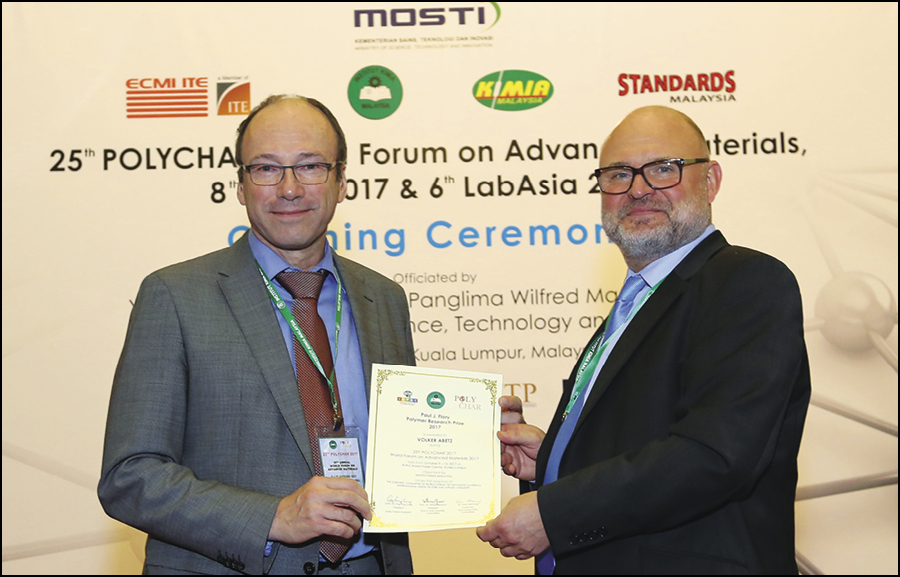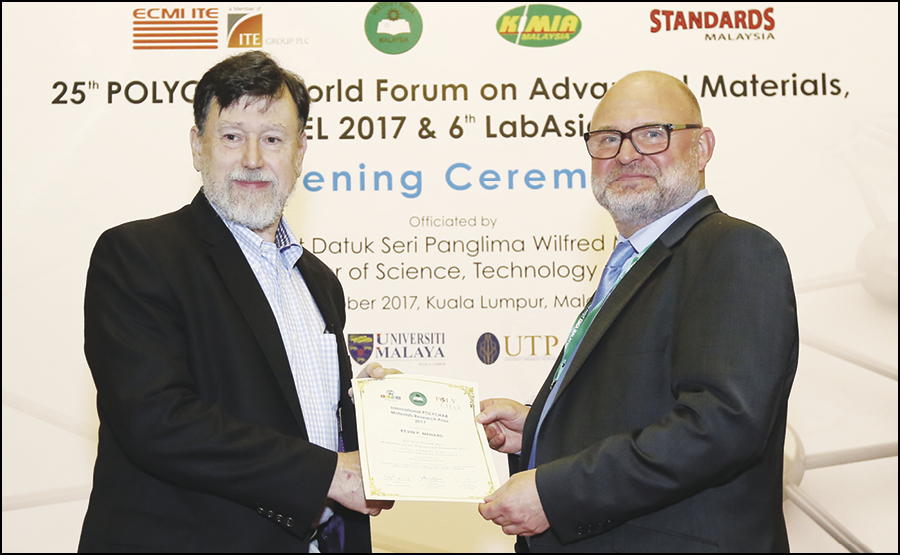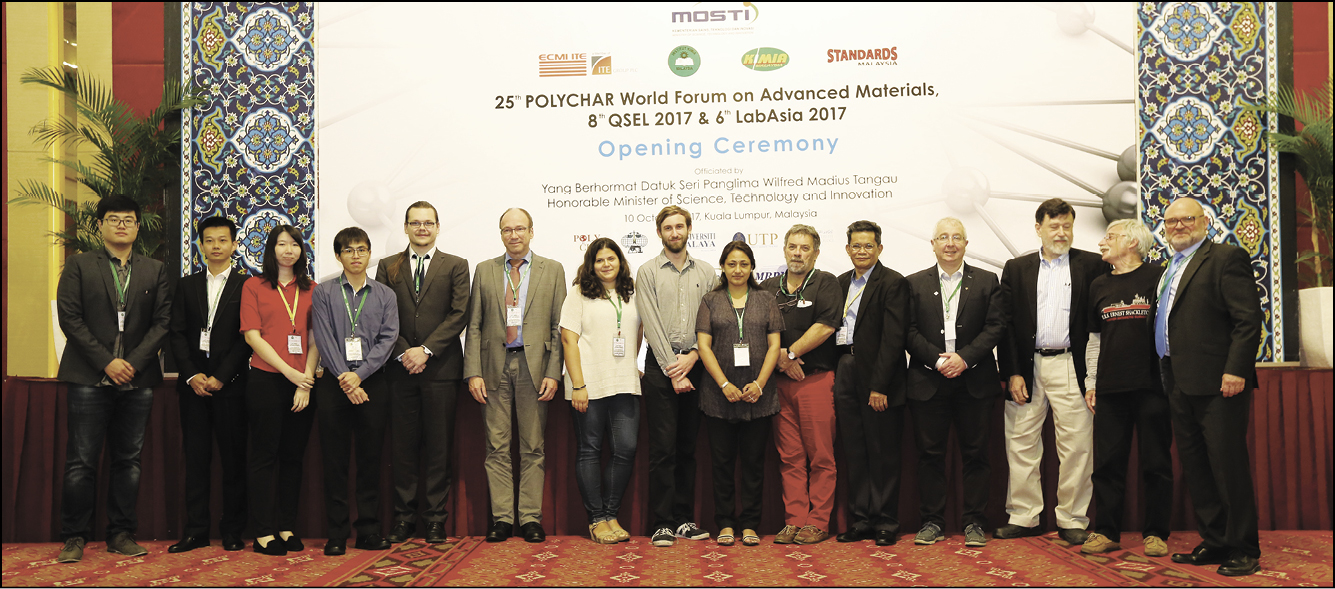Advanced Materials (POLYCHAR2017)
-
Chris Fellows

The 25th World Forum on Advanced Materials (POLYCHAR2017) (derived from POLYmer CHARacterization), under the auspices of the Scientific Committee of World Forum on Advance Materials and International Union of Pure and Applied Chemistry (IUPAC), was hosted by the Institut Kimia Malaysia at the Putra World Trade Centre, Kuala Lumpur, Malaysia on 9-13 October 2017. A total of 2 plenary, 99 invited, 55 oral, 48 posters and 21 participants from 31 countries were recorded. With the significance of the 25th anniversary of the series, it was an occasion for more than usual celebration, coinciding also with the 50th anniversary of both the Institute Kimia Malaysia and the IUPAC Polymer Division. The conference dinner was attended by the Malaysian Minister of Science, Technology and Innovation, Datuk Wilfred Madius Tangau. At the closing ceremony Dr. Kevin Menard (Veritas Testing and Consulting), one of the founders of POLYCHAR, talked about how far the series has come from its beginning as an opportunity for graduate students at the University of North Texas to practice giving presentations about their projects.
The philosophy of POLYCHAR is to visit a different part of the world each year to give students and young scientists an opportunity to present their scientific work to a larger international audience, to meet prominent scientists, and to attend tutorials held by international well-known scientists. Previous POLYCHAR meetings had been held in Denton, Texas, (where POLYCHAR had been founded in the year 1992), Guimaraes, Portugal (2004), Singapore (2005), Nara, Japan (2006), Buzios, Brazil (2007), Lucknow, India (2008), Rouen, France (2009), Siegen, Germany (2010), Kathmandu, Nepal (2011), Dubrovnik, Croatia (2012), Gwangju, South Korea (2013), Stellenbosch, South Africa (2014), Lincoln, Nebraska, USA (2015) and Poznan, Poland (2016).
Conference presentations ranged broadly over topics in polymer and composite chemistry, physics, and engineering. They were organised under the themes of:
Advanced biological, biomedical and environment-friendly polymers
Electroactive polymers
Latex chemistry and technology
Materials for clean and sustainable energy
Multi-techniques of materials characterization
Nanomaterials and smart materials
Natural and synthetic elastomers
Polymers and nutrition
Polymeric gels and soft matter
Processing, rheology and mechanical properties
Two plenary lectures were presented by Zairossani Mohd Nor [Deputy Director General, (Research and Innovation) of the Malaysian Rubber Board, Malaysia] on Positioning R&D towards innovative and sustainable rubber industry and Volker Abetz (University of Hamburg, Germany) on POLYmer Membrane CHARacterisation by scattering, microscopy, and thermal methods.
The Short Course, a POLYCHAR tradition, was supported by IUPAC and held on the first day of the meeting. Seven renowned researchers delivered graduate-level tutorial presentations on the following topics:
Characterization of polymer electrolytes by dielectric response using Electrochemical Impedance Spectroscopy (Chan Chin Han, University Technology MARA, Malaysia)
Thermal analysis used to analyze the glass transition phenomenon (Jean-Marc Saiter, University of Rouen, France)
Viscoelastic properties of polymers (Michael Hess, University of North Texas, USA)
A simple approach to the mathematical treatment of diffraction and scattering of X-ray and visible light (Masura Matsuo, Nara Women’s University, Japan)
Determination of thermodynamic properties by scattering techniques (Volker Abetz, University of Hamburg, Germany)

Joint opening ceremony of 25th World Forum on Advanced Materials (POLYCHAR2017); the 8th Biennial Regional Symposium on Total Laboratory Management—Quality, Safety, Environment and Laboratory Informatics (QSEL2017); and the LabAsia 2017 From left: Dato’ Dr. Ong Eng Long (President, IKM and the Organizing Chairman of POLYCHAR2017), Datuk Seri Panglima Wilfred Madius Tangau (Minister Of Science, Technology and Innovation Malaysia), Prof. Dr. Greg Russell (President of IUPAC Polymer Division), Prof. Dr. Jean-Marc Saiter (Vice President of POLYCHAR Scientific Committee), Mr. C P Saw (Managing Director of ECMI ITE), ), Assoc. Prof. Dr. Ramzah Dambal (Deputy Secretary-General of Ministry of Science, Technology and Innovation Malaysia) and Datuk Haji Ismail Bin Talib (Director General, Department of Chemistry Malaysia)

Short Course participants and speakers
Micromechanics of polymers by electron microscopy (Sven Henning, Fraunhofer Institute for Microstructure of Materials and Systems, Germany)
Characterisation of crosslinks in vulcanised rubbers: From simple to advanced techniques (presented by Kok Lang Mok of the Malaysian Rubber Board for Aik Hwee Eng of the Institute Kimia Malaysia).
The Short Course speakers were available for all participants for further discussions throughout the Forum and the short course notes can be accessed on IUPAC website (https://iupac.org/project/2016-033-1-400).
In the POLYCHAR tradition, a number of prizes were awarded at the conclusion of the event. The prestigious Paul J. Flory Research Prize 2017 went to Volker Abetz of Institute of Polymer Research of the Helmholtz-Zentrum Geesthacht and University of Hamburg, Germany, for his exemplary research into block copolymer behaviour.
The International POLYCHAR Materials Research Prize 2017 was awarded to Kevin Menard, one of the founders of the POLYCHAR series for his life’s work in the science of polymer materials.
The Bruce Hartmann Prize for Young Scientists was awarded to Valentina Marturano of the University of Naples, Italy, for her presentation entitled Visible light responsive polymer nanocapsules.
The Jürgen Springer Prize for Young Scientists was awarded to Dou Xiaoqiu of the University of Siegen, Germany, for her presentation entitled Novel 3D micropatterned poly(vinyl alcohol) hydrogel platform for the controlled formation of cell spheroids.
Three Carl Klason Student Awards were awarded to:
Florian Kung, Friedrich-Alexander-University Erlangen-Nuremberg, Germany, for his work on the suture-ability of grafts for ocular surface reconstruction;
Jian Liu, University of Science and Technology of China, for her presentation on Trifunctional CdSe Quantum Dots-Polymer Composite Film with Electrochromic, Electrofluorescent and Light-Induced Coloration Effects;
Jyoti Giri, Tribhuvan University, Nepal, for her presentation entitled Poly(butylene adipate-co-terephthalate) composites with wheat stalk microcellulose: morphological, mechanical, thermal and biodegradation behavior.
Three IUPAC Poster Prizes were awarded to:
Benoit Basse, Onyx Développement, for his poster on Peanut suspensions crosslinked by means of microbial transglutaminase;

Paul J. Flory Research Prize 2017: Volker Abetz (left) and Sven Henning (right—Chairman of POLYCHAR Prize Committee)

Paul J. Flory Research Prize 2017: Kevin Menard (left) and Sven Henning (right)
Khong Choy Hung, Tunku Abdul Rahman University, Malaysia, for her poster on Effect of carbon nanotubes in polyaniline nanocomposites on heavy metal removal;
Muchao Qu, Friedrich-Alexander-University Erlangen-Nuremberg, Germany, for her poster on Conductivity of melt spun poly(methyl methacrylate) composites with aligned carbon fibers.

Recipients of POLYCHAR Prizes, IUPAC Fellowship, members of POLYCHAR Scientific Committee, IUPAC Polymer Division and POLYCHAR2017 organizing committee
Four IUPAC Fellowships were offered by IUPAC for the support of graduate students and young scientists from developing countries, which were awarded to Chayaporn Pareseecharoen (Thailand), Jyoti Giri (Nepal), Lau Kam Sheng (Malaysia) and Manus Sriring (Thailand).
POLYCHAR 26 will return to Kathmandu, Nepal—the site of the very successful POLYCHAR 19—in March 2019. A POLYCHAR satellite meeting, TISAT 2018, is planned for Tbilisi, Georgia, in 2018.
Finally, the 6th Malaysia Scientific and Laboratory Equipment Exhibition and conference (LabAsia 2017) was held in conjunction with POLYCHAR2017 and QSEL 2017. This biennial international trade exhibition for laboratory equipment and services serving the ASEAN scientific community was jointly organised by IKM and ECMI ITE Asia Sdn Bhd. More than 6,000 visitors attended the three-day exhibition. LabAsia 2017 featured 154 exhibitors and principals from ten countries, including China, Germany, France, Britain and the United States, showcasing new products and services.
Assoc. Prof. Dr. Chris Fellows was IUPAC Representative and Assoc. Prof. Dr. Melissa Chan Chin Han was Secretary of Organizing Committee of POLYCHAR2017
©2018 IUPAC & De Gruyter. This work is licensed under a Creative Commons Attribution-NonCommercial-NoDerivatives 4.0 International License. For more information, please visit: http://creativecommons.org/licenses/by-nc-nd/4.0/
Articles in the same Issue
- Masthead - Full issue pdf
- Past President's Column
- A Good Beginning Makes a Good Ending
- Features
- Jamaican Chemists in Early Global Communication
- Everything Flows: Continuous Micro-Flow for Pharmaceutical Production
- Health for All in Dhaka: CHEMRAWN helps establish an International Centre for Natural Product Research
- Chemistry and Cultural Heritage*
- IUPAC Offers an Open Door to Chemists of the World*—A Program Revisited
- IUPAC Wire
- Sixth Polymer International–IUPAC Award goes to Cyrille Boyer
- Peter D.J. Grootenhuis is Awarded the 2018 IUPAC-Richter Prize
- The United Nations Proclaims the International Year of the Periodic Table of Chemical Elements
- World Metrology Day, 20 May 2018
- Science for Peace
- Resolution on the Water Crisis in Gaza
- The Chemical Weapons Convention: From Disarmament to Sustainable Development
- Project Place
- Interdivisional Discussion of Critical Evaluation of Chemistry Data
- Middle east regional cooperation and sustainable water management of transboundary water
- Chemical and Biochemical Thermodynamics Reunification
- Chemistry Teacher International
- Human Health Risk Consideration of Nano-Enabled Pesticides for Industry and Regulators
- IUPAC100 Periodic Table Challenge
- Making an imPACt
- Definition of the mole (IUPAC Recommendation 2017)
- On the future revision of the SI
- Reactions/comments to the new definition of the mole
- Terminology of separation methods (IUPAC Recommendations 2017)
- Interpreting and propagating the uncertainty of the standard atomic weights (IUPAC Technical Report)
- Mass and volume in analytical chemistry (IUPAC Technical Report)
- Risk assessment of effects of cadmium on human health (IUPAC Technical Report)
- Vocabulary on nominal property, examination, and related concepts for clinical laboratory sciences (IFCC-IUPAC Recommendations 2017)
- Bookworm
- “Speciation” Chemistry: Overdue for a Resurgence
- IUPAC Silver book—corrigendum
- Conference Call
- Chemistry and the Environment
- Advanced Materials (POLYCHAR2017)
- Bioorganic Chemistry in an Interdisciplinary Context
- Where 2B & Y
- Stamps International
- Cultural Heritage Chemistry
- Mark Your Calendar
Articles in the same Issue
- Masthead - Full issue pdf
- Past President's Column
- A Good Beginning Makes a Good Ending
- Features
- Jamaican Chemists in Early Global Communication
- Everything Flows: Continuous Micro-Flow for Pharmaceutical Production
- Health for All in Dhaka: CHEMRAWN helps establish an International Centre for Natural Product Research
- Chemistry and Cultural Heritage*
- IUPAC Offers an Open Door to Chemists of the World*—A Program Revisited
- IUPAC Wire
- Sixth Polymer International–IUPAC Award goes to Cyrille Boyer
- Peter D.J. Grootenhuis is Awarded the 2018 IUPAC-Richter Prize
- The United Nations Proclaims the International Year of the Periodic Table of Chemical Elements
- World Metrology Day, 20 May 2018
- Science for Peace
- Resolution on the Water Crisis in Gaza
- The Chemical Weapons Convention: From Disarmament to Sustainable Development
- Project Place
- Interdivisional Discussion of Critical Evaluation of Chemistry Data
- Middle east regional cooperation and sustainable water management of transboundary water
- Chemical and Biochemical Thermodynamics Reunification
- Chemistry Teacher International
- Human Health Risk Consideration of Nano-Enabled Pesticides for Industry and Regulators
- IUPAC100 Periodic Table Challenge
- Making an imPACt
- Definition of the mole (IUPAC Recommendation 2017)
- On the future revision of the SI
- Reactions/comments to the new definition of the mole
- Terminology of separation methods (IUPAC Recommendations 2017)
- Interpreting and propagating the uncertainty of the standard atomic weights (IUPAC Technical Report)
- Mass and volume in analytical chemistry (IUPAC Technical Report)
- Risk assessment of effects of cadmium on human health (IUPAC Technical Report)
- Vocabulary on nominal property, examination, and related concepts for clinical laboratory sciences (IFCC-IUPAC Recommendations 2017)
- Bookworm
- “Speciation” Chemistry: Overdue for a Resurgence
- IUPAC Silver book—corrigendum
- Conference Call
- Chemistry and the Environment
- Advanced Materials (POLYCHAR2017)
- Bioorganic Chemistry in an Interdisciplinary Context
- Where 2B & Y
- Stamps International
- Cultural Heritage Chemistry
- Mark Your Calendar

